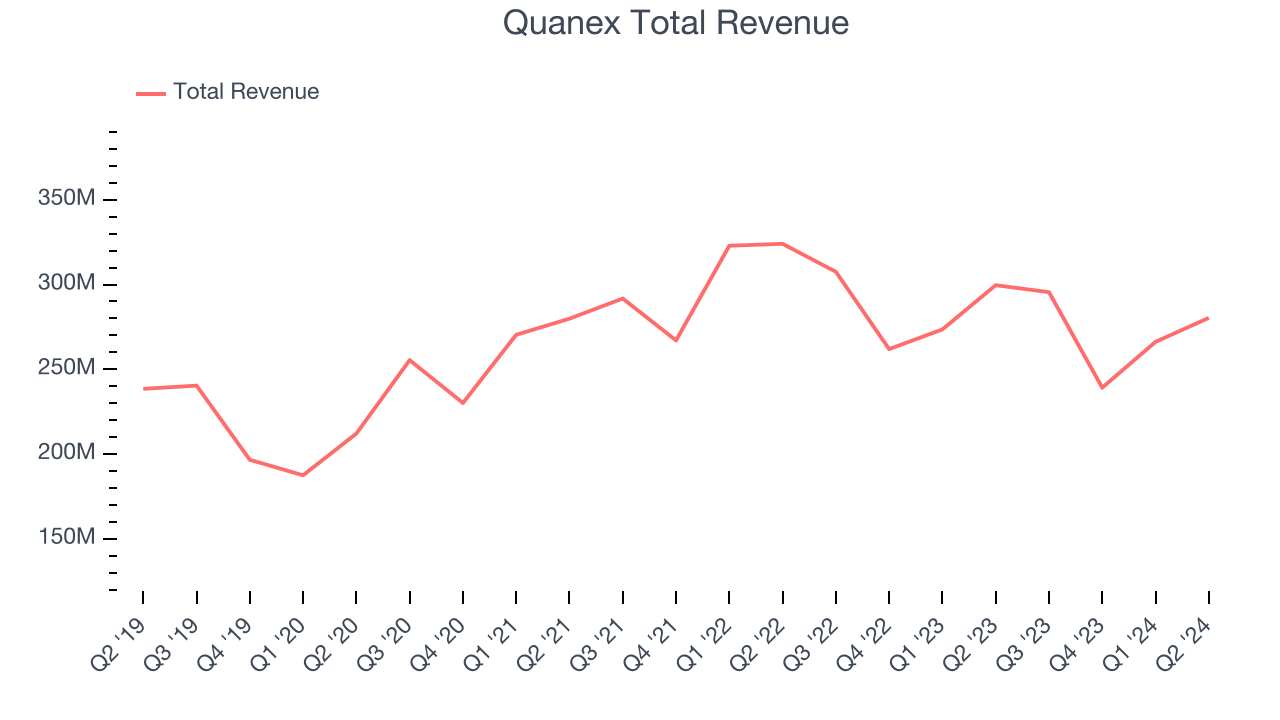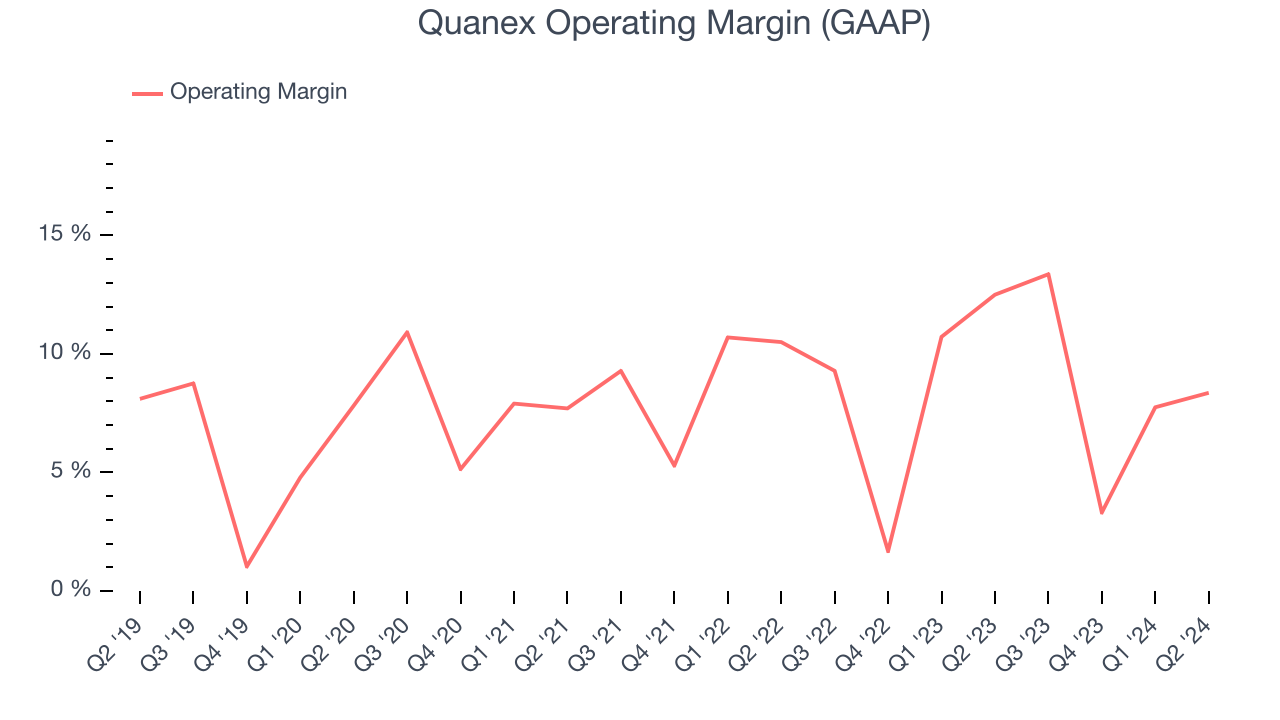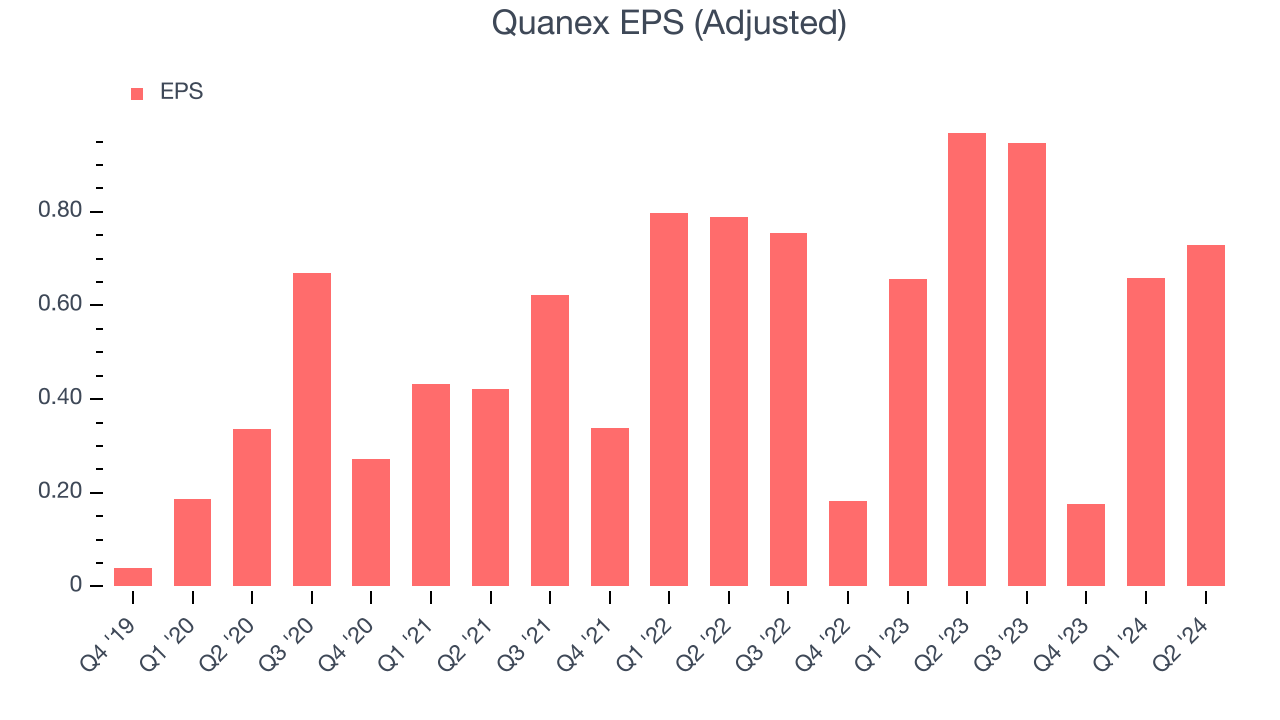Building products company Quanex (NYSE:NX) reported results in line with analysts’ expectations in Q2 CY2024, with revenue down 6.4% year on year to $280.3 million. The company’s outlook for the full year was also close to analysts’ estimates with revenue guided to $1.28 billion at the midpoint. It made a non-GAAP profit of $0.73 per share, down from its profit of $0.97 per share in the same quarter last year.
Is now the time to buy Quanex? Find out in our full research report.
Quanex (NX) Q2 CY2024 Highlights:
- Revenue: $280.3 million vs analyst estimates of $278.6 million (small beat)
- EPS (non-GAAP): $0.73 vs analyst estimates of $0.71 (3.3% beat)
- Revenue guidance for the full year is $1.28 billion at the midpoint, above analyst estimates
- EBITDA guidance for the full year is $173.5 million at the midpoint, below analyst estimates of $175 million
- Gross Margin (GAAP): 25.3%, in line with the same quarter last year
- EBITDA Margin: 0%, down from 16.2% in the same quarter last year
- Free Cash Flow Margin: 14.3%, down from 19% in the same quarter last year
- Market Capitalization: $830.8 million
George Wilson, Chairman, President and Chief Executive Officer, stated, “Overall, the results we reported for the third quarter of 2024 were consistent with our expectations. Consistent with the seasonality of our business, volumes increased across all operating segments in the third quarter of this year when compared to the second quarter. However, when compared to the prior year, demand remained soft, but we believe the building products industry will benefit from pent up demand once interest rates start to trend lower and consumer confidence is restored. All things considered, profitability for the quarter was as expected, but due to the decrease in volumes, coupled with lower operating leverage, margins declined year-over-year. Our continued focus on cash flow and managing working capital enabled us to generate approximately $40 million in free cash flow during the quarter."
Starting in the seamless tube industry, Quanex (NYSE:NX) manufactures building products like window, door, kitchen, and bath cabinet components.
Home Construction Materials
Traditionally, home construction materials companies have built economic moats with expertise in specialized areas, brand recognition, and strong relationships with contractors. More recently, advances to address labor availability and job site productivity have spurred innovation that is driving incremental demand. However, these companies are at the whim of residential construction volumes, which tend to be cyclical and can be impacted heavily by economic factors such as interest rates. Additionally, the costs of raw materials can be driven by a myriad of worldwide factors and greatly influence the profitability of home construction materials companies.
Sales Growth
A company’s long-term performance can indicate its business quality. Any business can put up a good quarter or two, but many enduring ones tend to grow for years. Regrettably, Quanex’s sales grew at a weak 3.8% compounded annual growth rate over the last five years. This shows it failed to expand in any major way and is a rough starting point for our analysis. 
Long-term growth is the most important, but within industrials, a half-decade historical view may miss new industry trends or demand cycles. Quanex’s history shows it grew in the past but relinquished its gains over the last two years, as its revenue fell by 5.3% annually.
We can better understand the company’s revenue dynamics by analyzing its most important segments, Fenestration and Cabinet Components, which are 79.1% and 18.4% of revenue. Over the last two years, Quanex’s Fenestration revenue (window and door components, North America only) averaged 3.4% year-on-year growth. On the other hand, its Cabinet Components revenue (cabinet parts, North America only) averaged 14.6% declines.
This quarter, Quanex reported a rather uninspiring 6.4% year-on-year revenue decline to $280.3 million of revenue, in line with Wall Street’s estimates. Looking ahead, Wall Street expects sales to grow 77.3% over the next 12 months, an acceleration from this quarter.
Today’s young investors won’t have read the timeless lessons in Gorilla Game: Picking Winners In High Technology because it was written more than 20 years ago when Microsoft and Apple were first establishing their supremacy. But if we apply the same principles, then enterprise software stocks leveraging their own generative AI capabilities may well be the Gorillas of the future. So, in that spirit, we are excited to present our Special Free Report on a profitable, fast-growing enterprise software stock that is already riding the automation wave and looking to catch the generative AI next.
Operating Margin
Operating margin is a key measure of profitability. Think of it as net income–the bottom line–excluding the impact of taxes and interest on debt, which are less connected to business fundamentals.
Quanex has done a decent job managing its expenses over the last five years. The company has produced an average operating margin of 8.2%, higher than the broader industrials sector.
Analyzing the trend in its profitability, Quanex’s annual operating margin rose by 2.6 percentage points over the last five years, showing its efficiency has improved.

This quarter, Quanex generated an operating profit margin of 8.4%, down 4.1 percentage points year on year. Since Quanex’s operating margin decreased more than its gross margin, we can assume the company was recently less efficient because expenses such as sales, marketing, R&D, and administrative overhead increased.
EPS
Analyzing long-term revenue trends tells us about a company’s historical growth, but the long-term change in its earnings per share (EPS) points to the profitability of that growth–for example, a company could inflate its sales through excessive spending on advertising and promotions.
Quanex’s full-year EPS grew at an astounding 29.2% compounded annual growth rate over the last four years, better than the broader industrials sector.

Like with revenue, we also analyze EPS over a shorter period to see if we are missing a change in the business. Quanex’s flat EPS over the last two years was weak but better than its 5.3% annualized revenue declines. However, this alone doesn’t tell us much about its day-to-day operations because its operating margin didn’t expand during this timeframe.
In Q2, Quanex reported EPS at $0.73, down from $0.97 in the same quarter last year. Despite falling year on year, this print beat analysts’ estimates by 3.3%. Over the next 12 months, Wall Street expects Quanex to grow its earnings. Analysts are projecting its EPS of $2.51 in the last year to climb by 10.7% to $2.78.
Key Takeaways from Quanex’s Q2 Results
We were impressed by how significantly Quanex blew past analysts’ Fenestration revenue expectations this quarter. We were also glad its full-year revenue guidance came in higher than Wall Street’s estimates. Overall, we think this was a solid quarter with some key areas of upside. The stock traded up 19.1% to $29.60 immediately after reporting.
Quanex may have had a good quarter, but does that mean you should invest right now? When making that decision, it’s important to consider its valuation, business qualities, as well as what has happened in the latest quarter. We cover that in our actionable full research report which you can read here, it’s free.
